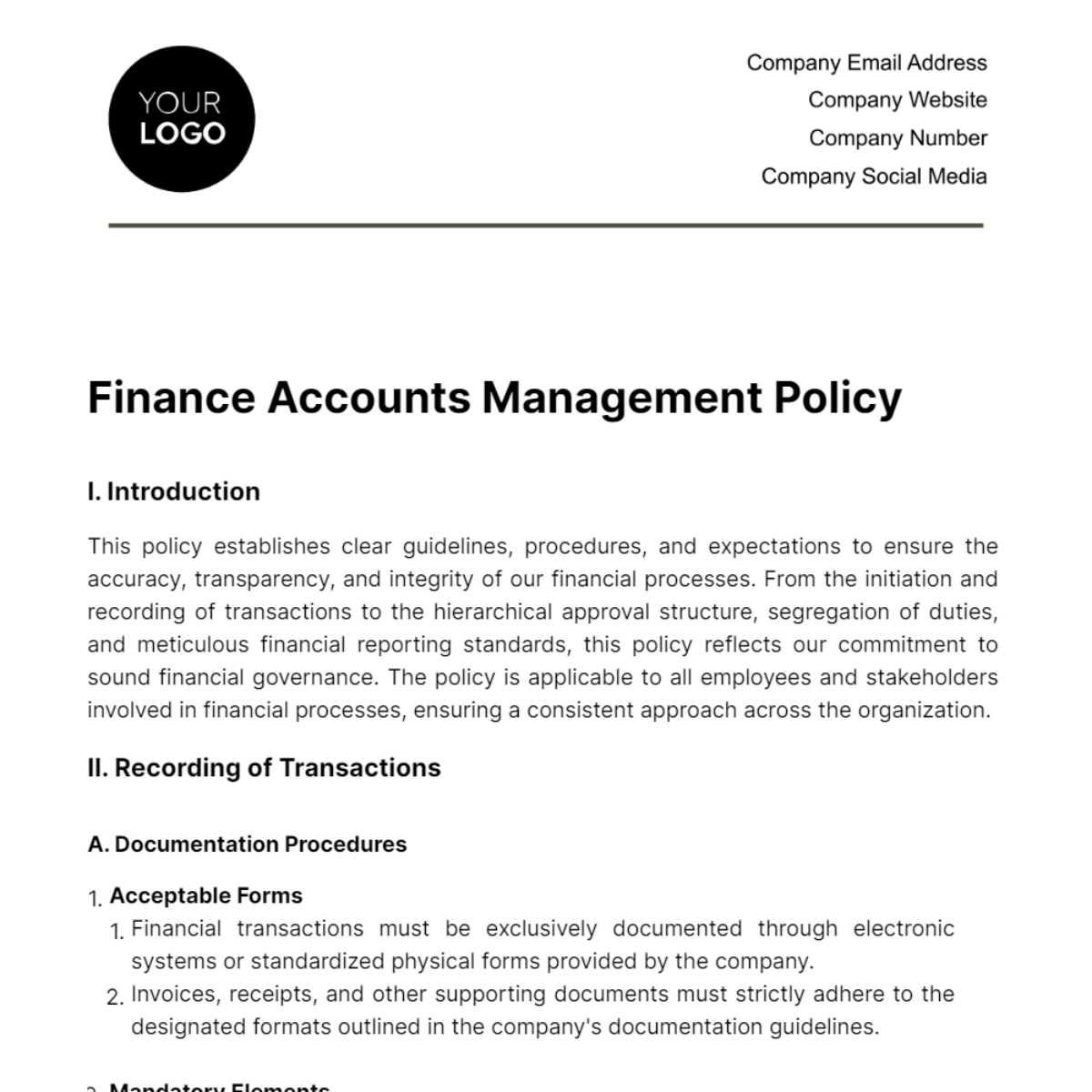Free Finance Accounts Management Policy

I. Introduction
This policy establishes clear guidelines, procedures, and expectations to ensure the accuracy, transparency, and integrity of our financial processes. From the initiation and recording of transactions to the hierarchical approval structure, segregation of duties, and meticulous financial reporting standards, this policy reflects our commitment to sound financial governance. The policy is applicable to all employees and stakeholders involved in financial processes, ensuring a consistent approach across the organization.
II. Recording of Transactions
A. Documentation Procedures
Acceptable Forms
Financial transactions must be exclusively documented through electronic systems or standardized physical forms provided by the company.
Invoices, receipts, and other supporting documents must strictly adhere to the designated formats outlined in the company's documentation guidelines.
Mandatory Elements
Every financial document must include the following mandatory elements:
Date of the transaction.
Transaction amount.
Detailed description of the transaction.
Identification of authorized personnel involved.
Failure to include any of these elements will render the documentation incomplete and subject to correction.
B. Verification Processes
All financial transactions require verification through a dual-approval system. This involves initiation by one individual and subsequent approval by another.
Initiators and approvers must be distinct individuals, and their roles are non-negotiable to ensure an unbiased verification process.
III. Authorization and Approval
In ensuring a systematic approach to authorization and approval processes, the table below illustrates the hierarchical structure and criteria for financial transaction approvals within the organization:
Approval Level | Transaction Magnitude | Criteria for Approval |
Level 1 | Up to $5,000 | Department Heads |
Level 1, encompassing transactions up to $5,000, involves department heads as the responsible authorities for approval. This level is designed to streamline the approval process for routine or lower-value transactions, allowing department heads to exercise their expertise in overseeing expenditures within their respective departments. This approach not only expedites the approval of smaller transactions but also ensures that decision-making authority is decentralized, empowering department heads to efficiently manage day-to-day financial activities,
IV. Segregation of Duties
A. Roles and Responsibilities
Initiator
Responsible for initiating financial transactions.
Ensures accuracy and completeness of transaction details.
Approver
Responsible for reviewing and approving initiated transactions.
Verifies compliance with policies and authorization criteria.
Record-Keeper
Responsible for maintaining accurate records of authorized transactions.
Ensures proper documentation and filing.
B. Prevention of Conflicts of Interest
Conflict Prevention Policy
Employees directly involved in financial transactions are strictly prohibited from holding conflicting roles within the organization.
This prohibition extends to activities that may compromise their objectivity or present conflicts of interest.
Consequences for Non-Compliance
Non-compliance with the Conflict Prevention Policy is considered a serious violation of organizational protocols.
Consequences for employees found in violation may include suspension from work, pending further investigation.
Repeat offenses may result in more severe disciplinary actions, including termination of employment.
V. Financial Reporting
A. Reporting Frequency
Internal management reports are required on a monthly basis to ensure up-to-date financial insights.
Failure to submit monthly reports within the specified timeframe may result in delayed decision-making and impact the organization's financial oversight.\
B. Accessibility of Reports
Financial reports are accessible to authorized personnel through a secure, centralized platform.
Unauthorized access attempts or breaches of the secure platform may result in disciplinary action, including but not limited to warnings and suspension.
VI. Risk Management
A. Risk Assessment Procedures
Conduct quarterly risk assessments for all financial activities, ensuring a proactive approach to identifying potential risks.
Use a standardized risk assessment framework to maintain consistency across assessments.
B. Mitigation Strategies
Establish a risk mitigation plan for each identified risk, outlining specific actions, responsibilities, and timelines.
Periodically review and update mitigation strategies based on the evolving risk landscape.
C. Continuous Monitoring
Implement real-time monitoring tools to detect emerging risks promptly.
Conduct semi-annual reviews of mitigation strategies' effectiveness, making adjustments as necessary to address new or changing risks.
- 100% Customizable, free editor
- Access 1 Million+ Templates, photo’s & graphics
- Download or share as a template
- Click and replace photos, graphics, text, backgrounds
- Resize, crop, AI write & more
- Access advanced editor
Establish sound accounts management with our Finance Accounts Management Policy Template from Template.net! This editable and customizable policy template defines clear guidelines for effective accounts management. Ensure compliance, mitigate risks, and enhance financial accountability with this essential tool for financial professionals. Tailor easily with our advanced AI Editor Tool today!





























